Careful diagnosis can help you get to the bottom of transmission complaints.
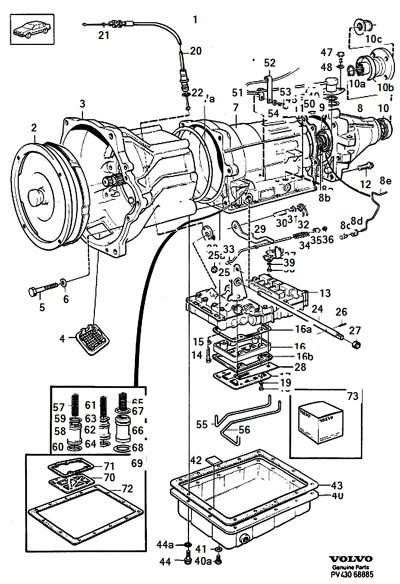
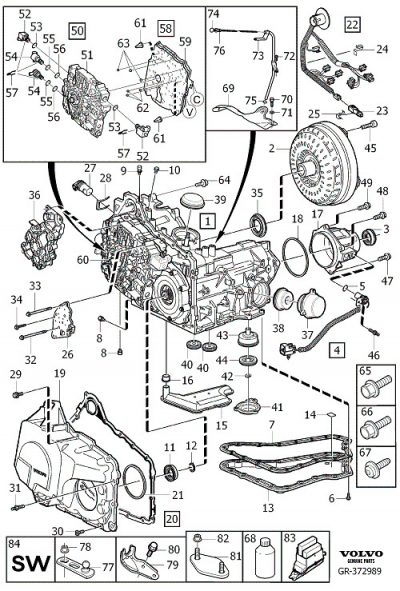
Over the years Volvo has used a large variety of transmissions and driveline systems in their cars. In the early days Volvo transmissions were simple and, like current Volvo transmissions, very reliable. Transmissions like the legendary AW70 and 71 used in most of the 240, 740, and 940 series cars were almost impossible to kill. Many shops have seen cases where a Volvo equipped with one of these beefy Swedish transmissions came into the shop with no fluid, or fluid contaminated with coolant from a bad radiator, just keep going after the leaks were fixed and new fluid was added.Â
Of course some of you older Volvo techs remember that a few 740 series cars came with a ZF-made transmission that was prone to failure if the engine was revved up when the car was in park, which happened quite a bit in the early days of emissions testing.
If you have been working on Volvos for a while, you know that Volvo has had some challenges with a few of their transmissions including the GM4T65EV used in S80 and XC90 models from 1999–2005.Â
There are still a lot of these XC90 and S80 Volvos on the road and many of them have had at least one transmission overhaul or replacement. Volvo has gone to great lengths to correct the problems in this transmission variant. Volvo was able to fix most of the weak points in the GMT65EV and updated the software so that the transmission worked better with the rest of the power train.Â
You will occasionally encounter one of these cars with the original transmission. If you get one of these XC90 or S80s in your shop with transmission problems make sure you advise the customer that a flush and fill with filter replacement is not likely to cure many transmission problems.
Since the GM4T65EV uses non-synthetic Dexron 3 transmission fluid, it’s critical to educate the drivers of these Volvos on the importance of regular fluid servicing at intervals specified in VIDA. If the customer drives in a high heat area or uses their Volvo for towing they should change the fluid more often.
With any transmission with higher mileage, if the transmission fluid is very dark or burnt, you should make sure the customer understands that there is a small possibility that changing the transmission fluid can make a weak transmission fail completely.

The magic words when it comes to transmission diagnosis or any repairs that you’re not 100% sure will fix the customers complaint are: “This is the first step…†or “we need to try this first.â€Â
But the real golden rule is manage customer expectations. Even though most technicians who are reading this are miracle workers (see Wizard in the dictionary), don’t promise miracles. The best way to sell diagnosis and repairs is to be honest and educate the customer on how the system works, the steps needed to properly diagnose the problem and the steps needed to repair it.Â
When you are diagnosing this transmission or any Volvo transmission issues, it’s important to get as much information as possible from the customer about the symptoms, such as frequency, noises, cold or hot, etc. The average customer is not a technician and will have to be asked leading questions, like, “When the problem occurred did it seem like the engine was revving but the car was not moving?†A good service writer knows how to elicit this valuable information from the customer.
Check for stored TCM and ECM codes. A lot of customers will mistake engine performance problems, such as a random misfire, for a transmission problem. And remember, just because there are no stored codes, this does not mean the transmission is OK. Always check for TSBs and Technical Journals. Volvo has several for transmission issues.
A lot of shift problems can be helped with a TCM software update, but of course software can’t fix mechanical damage.
You’re going to have to use Volvo’s VIDA tool to find out if the car you’re working on has the latest version of the TCM software installed. One of the cool new features of VIDA 2015 is that when you connect to a Volvo and go to the software tab, you will see the software updates that are available for the Volvo you’re working on. If you don’t see a TCM update under the available software update tab, it means that it is already installed with the latest version.Â
This is a lot better than earlier versions of VIDA, where you would just have to buy the software package and try to upload it, because the only way to find out if the car had the latest software was if the software loaded or failed and you got an error message that said, “The latest version of software already installed.†This was, of course, after you went through the whole software purchasing and download procedure.
With the newest version of VIDA a lot of things have improved compared to earlier versions. If you have used VIDA before but have not installed the online only version, VIDA 2015, you can read complete setup and purchasing instructions at volvotechinfo.com
If you have never used VIDA to diagnose Volvos in your shop, you are doing it the hard way. For 1999–present Volvos there is no better tool. Most generic scan tools will only talk to one module at a time. VIDA will let you look at the car’s entire network on one screen. With most generic scan tools, you will only see generic trouble codes. With VIDA you will get specific codes and their conditions, like intermittent, permanent, signal high, signal low and so on.Â
VIDA will pay for itself over and over. If you work on late model Volvos, it’s a must. For more info about ordering VIDA go to volvotechinfo.com.
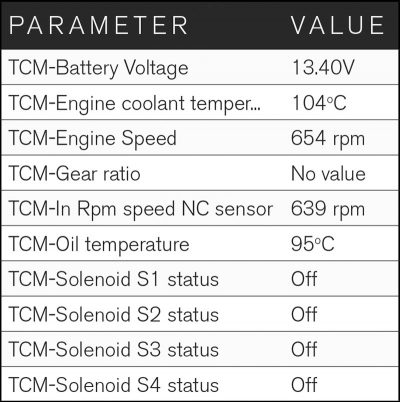
To get the most out of a road test for transmission problems, you should hook up your VIDA or other scan tool with a data recording function, so you can replay the data from the test drive to see what is out of range. The test-drive should be at least 20 minutes long and be both on city streets and at freeway speeds.
When checking live data from the TCM, the main data PIDs you should be checking are:Â
- Engine rpm
- Transmission main shaft rpm
- Output shaft rpm
- Gear ratio
- Shift solenoid status
- Transmission fluid temp
- Engine coolant temp
- TCM and ECM battery voltage
After the initial test drive, the car should be put on a lift for a visual inspection. Customers will often mistake suspension problems for a transmission issue. If the lower control arm bushings are worn out, the drive train can shift back and forth during heavy acceleration, braking and when the car upshifts.
Another problem that feels like harsh shifting can occur when the engine’s upper and/or lower torque mounts are broken.
If you get a Volvo in your shop that is experiencing both worn control arm bushings and engine torque mount failure, the car will clunk and bang around and feel generally unsafe. But if you have worn suspension, worn torque mounts and a slipping transmission, it will feel like the drive train is going to jump out of the car.Â
If you have shift solenoid codes, don’t automatically assume that a solenoid is defective. Watch the live data. If a solenoid is bad you will often see it not respond when the shift command is given. Â
If the transmission fluid is very dark, the 2nd gear clutches can be badly burned and damaged as well as 3rd gear clutches. When they are burned and glazed they will not hold as long as they should when applied, and slippage occurs. With excessive slippage you will experience long shifts that slide into each gear and seem delayed, and you may even feel the transmission slip out of gear as you slightly accelerate.Â
When the TCM detects that the commanded gear ratio did not occur, then it blames the shift solenoid for mechanically not doing its job, even though it likely is. The TCM doesn’t know any better and will set a fault code to best suit the condition; it knows nothing about the actual physical condition of the transmission.Â
Coolant ContaminationÂ
A lot of transmissions have failed because of coolant from the radiator mixing with the transmission fluid. This can be caused by the transmission cooler inside the radiator cracking or leaking. (Or is it?)
Which came first? The chicken or the egg?Â
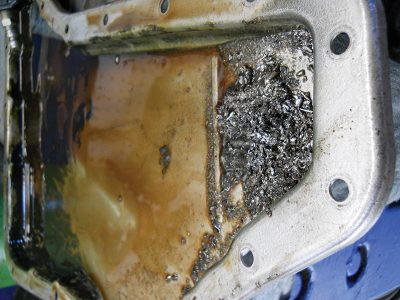
This is a classic example of this saying. Most technicians believe that the radiator fails and causes the damage to the transmission, but the fact is, it’s usually the transmission that takes out the radiator cooler pipe first. What happens in most cases is that metal debris from a failing torque converter or other worn internal transmission part is carried by the transmission fluid though the cooler pipe in the radiator.
So when the car is running, the metal contaminating the fluid acts like sandpaper and as this “sanding fluid†is forced through the transmission cooler pipe, the pipe develops holes and then you know what happens next. In any event, the radiator must be replaced and we suggest almost all Volvo models have the radiator replaced due to heavy contamination.Â
Unlike some other car makes, when a Volvo has coolant contamination in the transmission fluid, it’s not always easy to see. Later Volvos rarely will have visible cross contamination. Most of the Volvos that come into shops with this condition don’t show any sign of transmission fluid in the coolant, and the transmission fluid is almost never milky like you see on other cars with this problem.
So how can you tell?Â
The scientific approach is to get the customer to authorize a glycol test. Volvo has a test kit and procedure that is outlined in a TSB (RTJ-16724). The kits are available from Volvo or you can order them direct from Nelco:

Nelco Company LLC, Glyt-Tek Test Kit
1047 McKnight Rd. S.Â
Saint Paul, MN 55119
Phone: 651.738.2014
Fax: 651.738.9447
E-mail: Cvnelco@aol.com
intergarten.com/nelco/testkit.htm
The not-so-scientific approach is to drain the fluid through a coffee filter and check for metal shavings. If you have excessive metal in the fluid, the next step is to remove the transmission pan and check for excessive metal debris in the pan and on the magnets.
If the pan has so much silver and gold in it that you yell, “Eureka!†you can pretty much assume that this Volvo is going to need it all. Â
If your customer’s transmission fluid tests positive for coolant contamination or if there are a lot metal shavings in the pan, you’re going to have to tell the customer that they need to replace their transmission, radiator and transmission oil cooler (if equipped with one).
Also to be able to guarantee the transmission, you will need to flush out all the cooler lines and hoses. If there are a lot of metal shavings in the fluid you should recommend that the cooler hoses be replaced. And, of course, after the radiator is replaced, you will have to flush the coolant system for any lingering transmission fluid.
If you have a Volvo with intermittent symptoms, and no TCM codes, you can try changing the transmission fluid and updating the TCM software as a first step.Â
NOTE: The TCM software and fluid change is not an instant fix. Most times the car has to be driven a few hundred miles to see if it worked.Â
When changing the transmission fluid on a Volvo it’s critical to use the correct fluid type. Using the wrong fluid can cause performance problems and may eventually damage the transmission. Refer to VIDA for the correct fluid for the Volvo you’re working on.
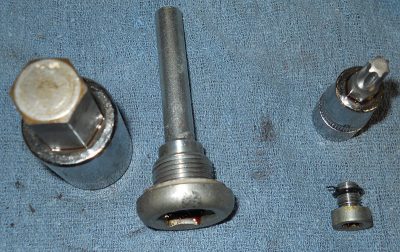
Checking the level and changing the transmission fluid on most Volvos is pretty straightforward. Drain and fill or use one of the cooler lines and a hose to drain while you fill through the dipstick tube. When you have to check or change the fluid on the newer AW-80SC and TF-80SC transmissions, the process is a bit more involved.Â
The AW-80SC and TF-80SC have no dipstick so when you check or replace the fluid use the following procedure:
- Beginning with a cold transmission (below 50°C/120°F oil temperature), remove the lower engine cover, the air snorkel, and the air cleaner with the MAF (Mass Airflow Sensor) and ECM.
- Remove filler plug (Torx 55) and place a clean funnel in the filler hole.
- Temporarily install the air cleaner with the MAF and ECM so that the engine can be started.
- Start the engine and leave it running for steps 5-9.
- Move the shifter from P to D. Stop at each position for at least two seconds. Do this twice.
- With the shift lever in P, raise the vehicle and place a receptacle under the transmission.
- Remove the level plug (Torx 40). Lower the vehicle and add oil to the transmission until it starts to run out of the level plug hole beneath the vehicle.
- Allow the transmission to warm up by letting the engine idle in P. During this time, some oil will be running out.
- When the oil temperature reaches 50°C/120°F, reinstall the level plug and turn off the engine.
- Reinstall the filler plug (Torx 55). Install the lower engine cover, the air cleaner correctly and the air snorkel.Â
A full version of the oil level checking procedure, can be found in VIDA. Note that it is not necessary to remove the air cleaner and ECM on S60R/V70R.
A word about installing used transmissions in a Volvo: DON’T! Transmission replacement is a major investment for your customer. Don’t take chances with your customer’s safety or your shop’s reputation by installing a possibly faulty used transmission. If it doesn’t work properly, you’ll have to replace it yet again. How much profit do you make when this happens? How much is your customer’s safety worth? Do yourself and your customer a big favor by doing the job right the first time. Use only OE Volvo factory rebuilt transmissions.
Download PDF


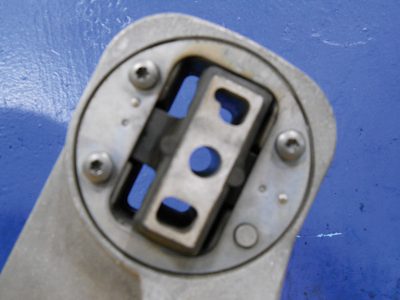
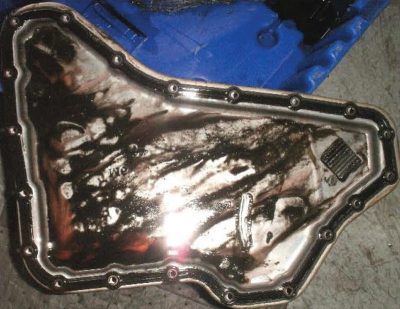





0 Comments